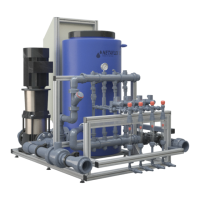
Do you have a question about the Netafim NETAFLEX 3G and is the answer not in the manual?
| Material | Polyethylene |
|---|---|
| Diameter | 16 mm |
| Color | Black |
| UV Resistance | Yes |
| Tube Diameter | 16 mm |
| Application | Irrigation |
| Connection Type | Barbed |
Defines symbols for Acid and Electrical Hazards to prevent injury or damage.
Defines symbols for Safety Footwear and Protective Equipment to prevent injury.
Defines symbols for Warning, Caution, Attention, Note, Example, and Tip for operation guidance.
General safety guidelines for system installation and operation.
Instructions on wearing protective footwear and preventing water pollution.
Precautions for valve operation to prevent water hammer damage.
Guidelines for safe handling and use of acids and chemicals with the system.
Warnings regarding acid concentrations and corrosive substances for system integrity.
Overview of the NetaFlex™™ 3G, its features, and key advantages.
Details on system highlights, advantages like efficiency, and flexibility.
Technical specifications, dual volume system, and available add-ons.
Illustrates a typical NetaFlex™™ 3G infrastructure with labeled components.
Detailed schematic showing system components and flow of water and fertilizers.
Provides external dimensions, package dimensions, and weights for different pump configurations.
Describes automatic operation and necessary conditions for the NetaFlex™™ 3G.
Details on dual dosing channels and critical fertilizer combinations to avoid.
Outlines essential maintenance tasks, safety precautions, and inspection schedules.
Precautions to ensure no system pressure before calibrating EC/pH sensors.
Regular checks of pressure and flow rates to ensure optimal hydraulic conditions.
Steps to protect the system from freezing during winter idle periods, including safety precautions.
Safety warnings, pre-checks, and precautions before starting troubleshooting.
Identifies symptoms and actions for problems affecting multiple dosing channels.
Lists symptoms and troubleshooting steps for single dosing channel malfunctions.
Addresses controller warnings and actions for system idle problems and valve leaks.
Troubleshooting steps for when the system fails to operate or shows 'NO FLOW'.
Method for calculating the correct opening percentage for dosing channels.
Procedure for simulating dosing accuracy using a test bucket and necessary instruments.
Procedure for calibrating the system during an actual irrigation cycle, with safety warnings.
Notes on controller interface, sensor calibration, rotameter accuracy, and valve settings.
Guidance on adjusting dosing valve opening for varying field flow rates and deviation limits.
Exploded views and part identification for 200L pump configurations.
Table listing main components, descriptions, and catalog numbers for ordering.
Exploded view and part identification for the dosing channel assembly.
Detailed lists of dosing channel and Venturi components with catalog numbers.
List of system pumps with their electrical data for 50Hz and 60Hz installations.
Section for recording reference data for hydraulic conditions during system commissioning.
Proper storage of pH sensors when not installed to prevent damage and maintain warranty.